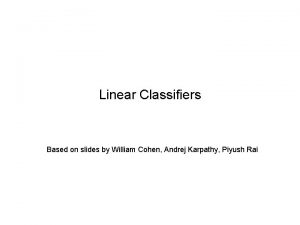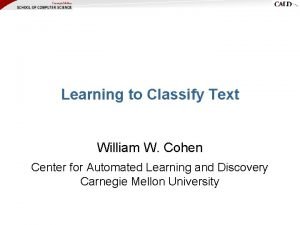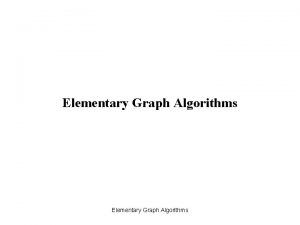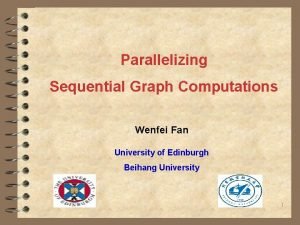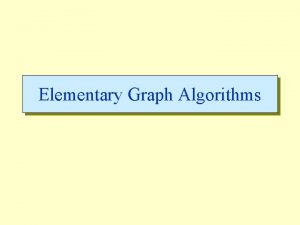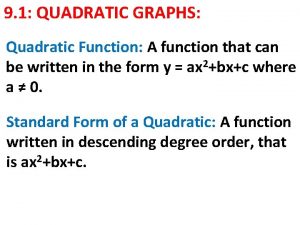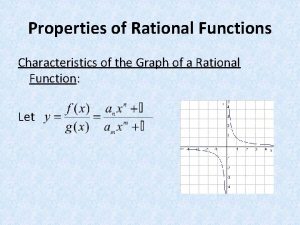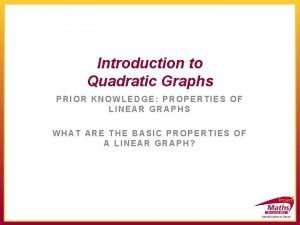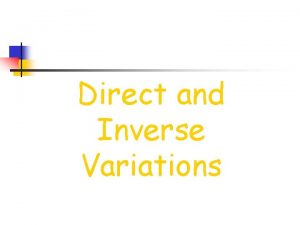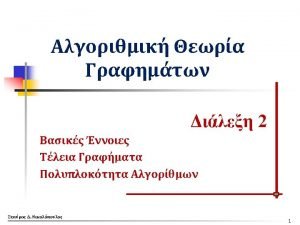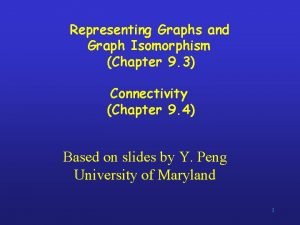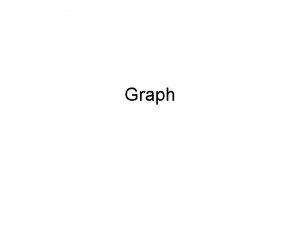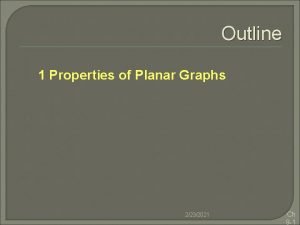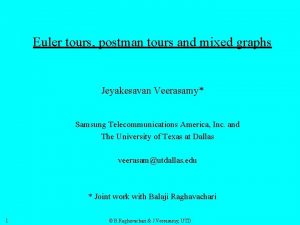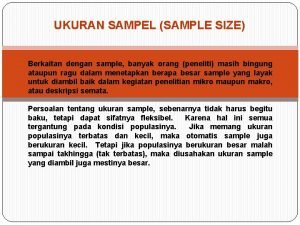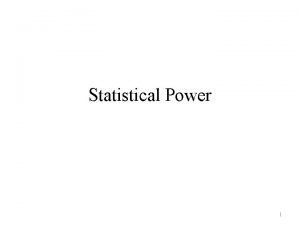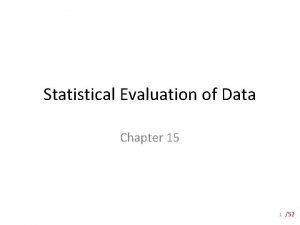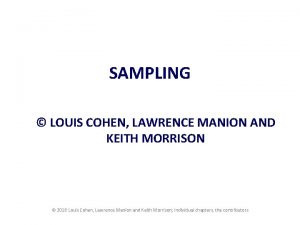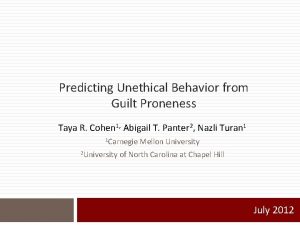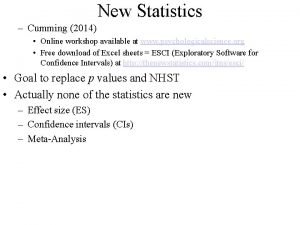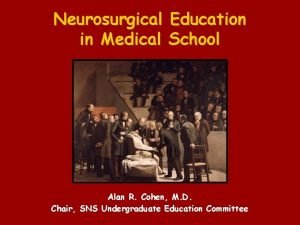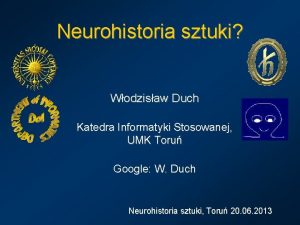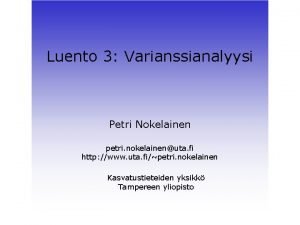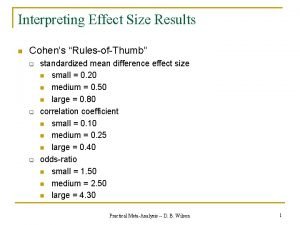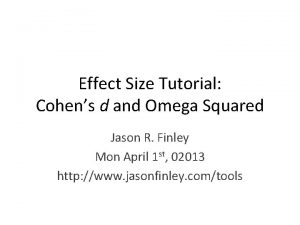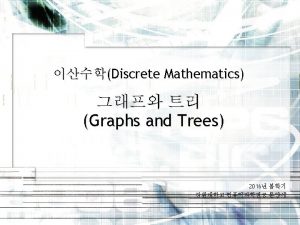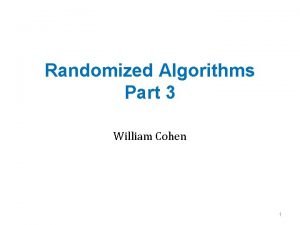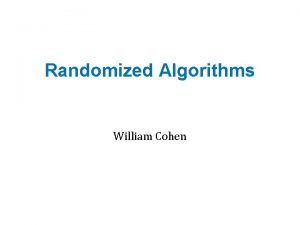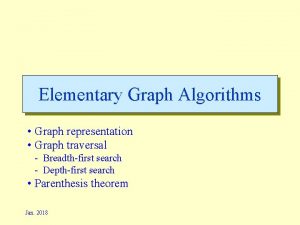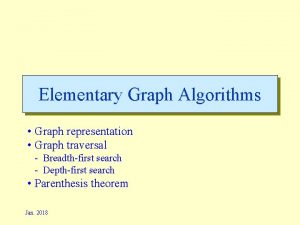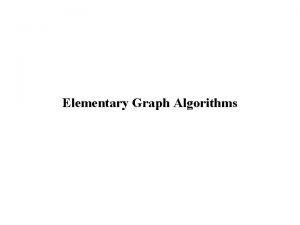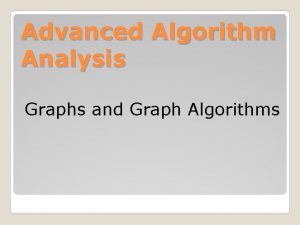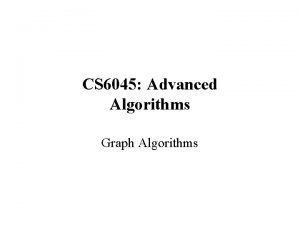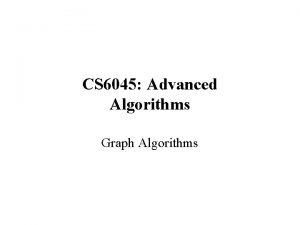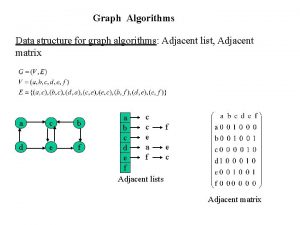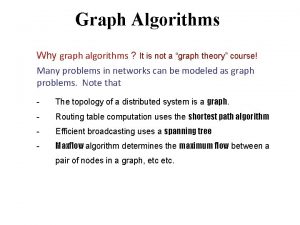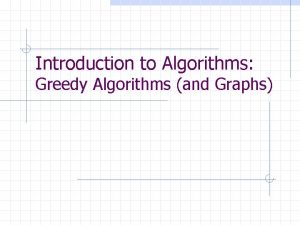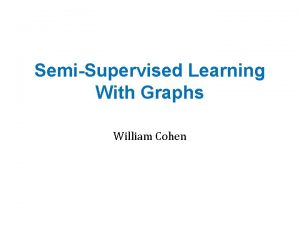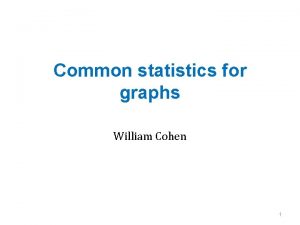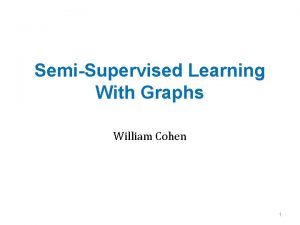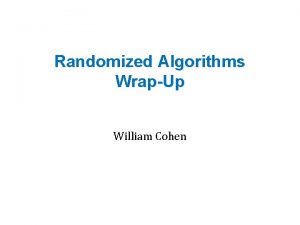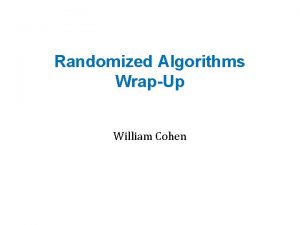Graph Algorithms Properties of Graphs William Cohen Outline



















































- Slides: 51

Graph Algorithms: Properties of Graphs? William Cohen

Outline • Last week: – Page. Rank – one algorithm on graphs • edges and nodes in memory • nothing in memory • This week: – William’s lecture • (Semi)Supervised learning on graphs • Properties of (social) graphs – Joey Gonzales guest lecture • Graph. Lab

Why I’m talking about graphs • Lots of large data is graphs – Facebook, Twitter, citation data, and other social networks – The web, the blogosphere, the semantic web, Freebase, Wikipedia, Twitter, and other information networks – Text corpora (like RCV 1), large datasets with discrete feature values, and other bipartite networks • nodes = documents or words • links connect document word or word document – Computer networks, biological networks (proteins, ecosystems, brains, …), … – Heterogeneous networks with multiple types of nodes • people, groups, documents

Properties of Graphs Descriptive Statistics • Number of connected components • Diameter • Degree distribution • … Models of Growth/Formation • Erdos-Renyi • Preferential attachment • Stochastic block models • …. Let’s look at some examples of graphs … but first, why are these statistics important?

An important question • How do you explore a dataset? – compute statistics (e. g. , feature histograms, conditional feature histograms, correlation coefficients, …) – sample and inspect • run a bunch of small-scale experiments • How do you explore a graph? – compute statistics (degree distribution, …) – sample and inspect • how do you sample?

Karate club

Schoolkids

Heart study participants

College football

books


citations




How do you model graphs?

What are we trying to do? Normal curve: • Data to fit • Underlying process that “explains” the data • Closed-form parametric form • Only models a small part of the data

Graphs • Set V of vertices/nodes v 1, … , set E of edges (u, v), …. – Edges might be directed and/or weighted and/or labeled • Degree of v is #edges touching v – Indegree and Outdegree for directed graphs • Path is sequence of edges (v 0, v 1), (v 1, v 2), …. • Geodesic path between u and v is shortest path connecting them – Diameter is max u, v in V {length of geodesic between u, v} – Effective diameter is 90 th percentile – Mean diameter is over connected pairs • (Connected) component is subset of nodes that are all pairwise connected via paths • Clique is subset of nodes that are all pairwise connected via edges • Triangle is a clique of size three

Graphs • Some common properties of graphs: – Distribution of node degrees – Distribution of cliques (e. g. , triangles) – Distribution of paths • Diameter (max shortest-path) • Effective diameter (90 th percentile) • Connected components – … • Some types of graphs to consider: – Real graphs (social & otherwise) – Generated graphs: • Erdos-Renyi “Bernoulli” or “Poisson” • Watts-Strogatz “small world” graphs • Barbosi-Albert “preferential attachment” • …

Erdos-Renyi graphs • Take n nodes, and connect each pair with probability p – Mean degree is z=p(n-1)

Erdos-Renyi graphs • Take n nodes, and connect each pair with probability p – Mean degree is z=p(n-1) – Mean number of neighbors distance d from v is zd – How large does d need to be so that zd >=n ? • If z>1, d = log(n)/log(z) • If z<1, you can’t do it – So: • There tend to be either many small components (z<1) or one large one (z<1) giant connected component) – Another intuition: • If there a two large connected components, then with high probability a few random edges will link them up.



Erdos-Renyi graphs • Take n nodes, and connect each pair with probability p – Mean degree is z=p(n-1) – Mean number of neighbors distance d from v is zd – How large does d need to be so that zd >=n ? • If z>1, d = log(n)/log(z) • If z<1, you can’t do it – So: • If z>1, diameters tend to be small (relative to n)

Sociometry, Vol. 32, No. 4. (Dec. , 1969), pp. 425 -443. 64 of 296 chains succeed, avg chain length is 6. 2

Illustrations of the Small World • Millgram’s experiment • Erdős numbers – http: //www. ams. org/mathscinet/searchauthors. html • Bacon numbers – http: //oracleofbacon. org/ • Linked. In – http: //www. linkedin. com/ – Privacy issues: the whole network is not visible to all



Erdos-Renyi graphs • Take n nodes, and connect each pair with probability p – Mean degree is z=p(n-1) This is usually not a good model of degree distribution in natural networks

Degree distribution • Plot cumulative degree – X axis is degree – Y axis is #nodes that have degree at least k • Typically use a log-log scale – Straight lines are a power law; normal curve dives to zero at some point – Left: trust network in epinions web site from Richardson & Domingos

Degree distribution • Plot cumulative degree – X axis is degree – Y axis is #nodes that have degree at least k • Typically use a log-log scale – Straight lines are a power law; normal curve dives to zero at some point • This defines a “scale” for the network – Left: trust network in epinions web site from Richardson & Domingos

Friendship network in Framington Heart Study



Graphs • Some common properties of graphs: – Distribution of node degrees – Distribution of cliques (e. g. , triangles) – Distribution of paths • Diameter (max shortest-path) • Effective diameter (90 th percentile) • Connected components – … • Some types of graphs to consider: – Real graphs (social & otherwise) – Generated graphs: • Erdos-Renyi “Bernoulli” or “Poisson” • Watts-Strogatz “small world” graphs • Barbosi-Albert “preferential attachment” • …

Graphs • Some common properties of graphs: – Distribution of node degrees: often scale-free – Distribution of cliques (e. g. , triangles) – Distribution of paths • Diameter (max shortestpath) • Effective diameter (90 th percentile) often small • Connected components usually one giant CC – … • Some types of graphs to consider: – Real graphs (social & otherwise) – Generated graphs: • Erdos-Renyi “Bernoulli” or “Poisson” • Watts-Strogatz “small world” graphs • Barbosi-Albert “preferential attachment” generates scale-free graphs • …

Barabasi-Albert Networks • Science 286 (1999) • Start from a small number of node, add a new node with m links • Preferential Attachment • Probability of these links to connect to existing nodes is proportional to the node’s degree • ‘Rich gets richer’ • This creates ‘hubs’: few nodes with very large degrees

Random graph (Erdos Renyi) Preferential attachment (Barabasi-Albert)

Graphs • Some common properties of graphs: – Distribution of node degrees: often scale-free – Distribution of cliques (e. g. , triangles) – Distribution of paths • Diameter (max shortestpath) • Effective diameter (90 th percentile) often small • Connected components usually one giant CC – … • Some types of graphs to consider: – Real graphs (social & otherwise) – Generated graphs: • Erdos-Renyi “Bernoulli” or “Poisson” • Watts-Strogatz “small world” graphs • Barbosi-Albert “preferential attachment” generates scale-free graphs • …

Homophily • One definition: excess edges between similar nodes – E. g. , assume nodes are male and female and Pr(male)=p, Pr(female)=q. – Is Pr(gender(u)≠ gender(v) | edge (u, v)) >= 2 pq? • Another def’n: excess edges between common neighbors of v

Homophily • Another def’n: excess edges between common neighbors of v

Homophily • In a random Erdos-Renyi graph: In natural graphs two of your mutual friends might well be friends: • Like you they are both in the same class (club, field of CS, …) • You introduced them

Watts-Strogatz model • Start with a ring • Connect each node to k nearest neighbors • homophily • Add some random shortcuts from one point to another • small diameter • Degree distribution not scale-free • Generalizes to d dimensions


An important question • How do you explore a dataset? – compute statistics (e. g. , feature histograms, conditional feature histograms, correlation coefficients, …) – sample and inspect • run a bunch of small-scale experiments • How do you explore a graph? – compute statistics (degree distribution, …) – sample and inspect • how do you sample?

KDD 2006

Brief summary • Define goals of sampling: – “scale-down” – find G’<G with similar statistics – “back in time”: for a growing G, find G’<G that is similar (statistically) to an earlier version of G • Experiment on real graphs with plausible sampling methods, such as – RN – random nodes, sampled uniformly –… • See how well they perform

Brief summary • Experiment on real graphs with plausible sampling methods, such as – RN – random nodes, sampled uniformly • RPN – random nodes, sampled by Page. Rank • RDP – random nodes sampled by in-degree – RE – random edges – RJ – run Page. Rank’s “random surfer” for n steps – RW – run RWR’s “random surfer” for n steps – FF – repeatedly pick r(i) neighbors of i to “burn”, and then recursively sample from them

10% sample – pooled on five datasets

d-statistic measures agreement between distributions • D=max{|F(x)-F’(x)|} where F, F’ are cdf’s • max over nine different statistics

 Azeureus
Azeureus William cohen norman
William cohen norman Levenshtein
Levenshtein William w. cohen
William w. cohen What is state graph in software testing
What is state graph in software testing Speed and velocity
Speed and velocity Graphs that enlighten and graphs that deceive
Graphs that enlighten and graphs that deceive Polynomial end behavior chart
Polynomial end behavior chart Dfs algorithm
Dfs algorithm Incrementalizing graph algorithms
Incrementalizing graph algorithms W graph
W graph Undirected graph algorithms
Undirected graph algorithms Quadratic graphs and their properties
Quadratic graphs and their properties Properties of rational function
Properties of rational function Investigating graphs of functions for their properties
Investigating graphs of functions for their properties Investigating graphs of polynomial functions
Investigating graphs of polynomial functions Properties of quadratic graphs
Properties of quadratic graphs Properties of quadratic graphs
Properties of quadratic graphs Euler
Euler Direct inverse graph
Direct inverse graph Algorithmic graph theory and perfect graphs
Algorithmic graph theory and perfect graphs Representing graphs and graph isomorphism
Representing graphs and graph isomorphism Representing graphs and graph isomorphism
Representing graphs and graph isomorphism Example of a sentence outline
Example of a sentence outline Lesson outline lesson 2 - physical properties answer key
Lesson outline lesson 2 - physical properties answer key Wave properties lesson 2
Wave properties lesson 2 Euler curcuit
Euler curcuit Extensive vs intensive
Extensive vs intensive Chemical property of water
Chemical property of water Properties of planar graph
Properties of planar graph Local markov assumption
Local markov assumption Eulerian graph properties
Eulerian graph properties Line graph graph theory
Line graph graph theory Wait-for graph
Wait-for graph N=z2pq/d2
N=z2pq/d2 Cohen's effect size
Cohen's effect size Cohen's d effect size criteria
Cohen's d effect size criteria Cohen manion and morrison 2018
Cohen manion and morrison 2018 Taya cohen
Taya cohen Cohens d formula
Cohens d formula Alan cohen neurosurgery
Alan cohen neurosurgery Harold cohen aaron
Harold cohen aaron Cohen's f
Cohen's f Minimum sample for correlation
Minimum sample for correlation General linear model
General linear model Leonard norman
Leonard norman Cohen kappa formula
Cohen kappa formula Eliahu cohen
Eliahu cohen How to find cohen's d
How to find cohen's d I have not lingered in european monasteries
I have not lingered in european monasteries Austin and aiden cohen
Austin and aiden cohen Negative omega squared
Negative omega squared

